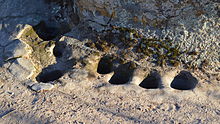Nisenan
According to a 1929 archeology and ethnology press release by University of California, Berkeley, the Nisenan people are classified as part of the larger group of Native Americans known as the Maidu, though some dispute the accuracy of this relationship,[2] including the Nisesan themselves.
However, the Nisenan are a separate Tribe with their own Cultural lifeways, their own leaders and holy people, a distinct geographic territory and their own ancient and unique language.
Some Nisenan people today are enrolled in the Shingle Springs Band of Miwok Indians, a federally recognized tribe.
The Nisenan live in Northern California, between the Sacramento River to the west and the Sierra Mountains to the east.
The 1849 Gold Rush attracted hundreds of thousands of Europeans to the area, resulting in appropriation of their lands, decimation of their resources, more disease, violence, and mass murder.
[7] The influx of numerous migrants resulted in overuse of land, competition for game and water, and a strain on resources and the environment.
A fraction of the surviving Nisenan remained in the Sierra Nevada foothills and acquired low-wage jobs.
[7] Documented history about customs can be contradictory and not always reliable, as early anthropologists were often researching several regions at once, often well after disruptions and trauma to tribes had already occurred due to European contact.
[7] But Richard B. Johnson, current Tribal Chairman for the Nevada City Nisenan, said, "Our elders have said that twins were not killed, but were considered fortunate if both survived during infancy.
[13] The new mother slept in a seated position for the first sixteen days after birth,[14] with a heated flat stone placed on the belly to assist with passage of the afterbirth.
[18] Cremation was the most feasible practice for tribes, primarily for those of a nomadic lifestyle, due to easier transportation and to limit grave robberies.
[18] The deceased were thought to have the ability to take the forms of either creatures or weather patterns, but were not welcomed by the living community.
They were previously documented as four dialects, classified as: The Spanish invaded and occupied Alta California in the late 18th century.
Franciscan missions were built in California to settle the area, spread the Roman Catholic religion, extract resources from the land, and enslave indigenous people for their labor.
They were relatively undisturbed by Spanish missionaries and religious missions, though Spanish and Mexican troops occasionally set foot on Nisenan land to capture enslaved indigenous people who had fled (many of whom in one particular example were of the neighboring Miwok tribe), find livestock, or traverse the land.
The people were highly decentralized, in small groups who shared a common language, with a wide spectrum on similar dialects.
The Nisenan people historically lived as a number of small, self-sufficient, autonomous communities.
Early documentation about the social organization of the tribe failed to account for the female Nisenan perspective, their voices and inclusion.
Nisenan tribal families hold knowledge and memory of a shared society that was equally matriarchal|matrilineal in form and function.
They in turn traded black acorns, pine nuts, berries, animal skins, and wood needed to make bows[24] As of 2020, about 147 Nisenan were residing in Nevada City, California.
Extremely high rates of under-education, under-employment, drug and alcohol addiction, domestic violence, suicide, and poor health persist within the community.
Nisenan Heritage Day is held annually to showcase ceremonial dances and allow attendees insight as well as participation in traditional practices such as basket weaving.
Additional efforts are put towards educating people on their language as they view it as their "connection to the land itself.
"[25] In 2024 the Nevada City Rancheria Nisenan Tribe through the 501(c)(3) non-profit California Heritage Indigenous Research Project launched its "Homeland Return" campaign to raise funds to purchase the former John Woolman School.


